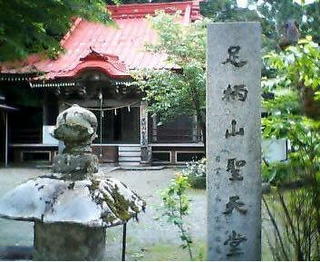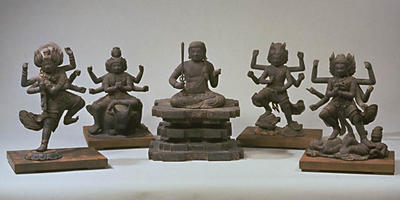:::::::::::::::::::::::::::::::::::::::::::::::::::::::::::::::::::::::::::::::::::::::::::::::::::::
Kankiten (Kangiten 歓喜天, also
Shooten 聖天;
Vinaayaka, Nandikeshvara, Ganesh)
kigo for the New Year
Hatsu Shooten 初聖天 (はつしょうてん)
First Ceremony for Shoten

:::::::::::::::::::::::::::::::::::::::::::::::::::::::::::::::::::::::::::::::::::::::::::::::::::::
Ganesh, the elephant-headed deity of Hinduism, is the son of Shiva and Paarvati. He is the brother of Idaten.
He moves freely in the 3000 realms and is lord of 9800 demons.
The Japanese name "Daishoo Kangiten" is the pronounciation of the "Ganabachi" (Ganesh).
He belongs to the group of TEN deities (tenbu 天部) in Japanese Buddhism.
In esoteric Buddhism this deity is often shown as two human-like figures with an elephant head, embracing each other. As such, they are venerated with prayers for good marriage and children. The male deity is thought of as the oldes son of Daijizaiten 大自在天, the "great wild god" Daiboojin 大暴神).
To calm this wild god, the female is an incarnation of the eleven-headed Kannon Bosatsu, who converted this wild god to Buddhism. She is capable of intensive meditation (kanjin) and thus calms his wildness. So the name of these two is "Deity of Joy" (Kankiten, Kangiten).
The statues of these embracing deities are usually not shown to the public, because of the sexual implication. Thye are kept in separate shrines behind closed doors, the so-called Secret Statues (hibutsu 秘仏).
There are more than 250 temples in Japan, where Ganesh is venerated.
In Kamakura at the temple Hookaij-Ji 宝戒寺 is a Kangiten Hall where you find the oldest statue of a Kankiten in Japan. He is said to be especially powerful and therefore kept locked in a tabernakel since 1333. This is located in a separate hall for the deity.
In special exorcistic rituals of these deities the statues are usually poored over with oil, mostly hot oil.
Kankiten statues are also venerated from people in the restaurant business.
... ... ... Iconography
Body of a human being with an elephant head. Dressed like figures of a bosatsu. Sometime holding weapons, more often a large raddish (daikon大根) with two roots.
The elephant head of the male (nanten 男天) is placed on the right shoulder of the female (nyoten 女天), the head of the woman placed on the read shoulder of the male. So we can only see the back of the statues. The female wears jewelery on the head. Their feet are opposite each other, the female stepping on the toes of the male. Their hands are at the hips of each other.
In Mongolian statues, Ganesh is often depicted with a flame-halo.
Indian statues of Ganesh depict him standing on a rat.
Gabi Greve
Read about my encounter with the Kanki-Ten in Kamakura
Ganesh The elelphant-headed god in the India Saijiki
... ... ... ... ...

You can get this statue online here:
http://store.yahoo.co.jp/kurita/bdf4c5b7bfc0a4cec9f4-b4bfb4eec5b7.html
(C) Kurita Trading CO.,LTD 栗田貿易有限会社
:::::::::::::::::::::::::::::::::::::::::::::::::::::::::::::::::::::::::::::::::::::::::::::::::::::

At Miyajima, Japan
They are unusual because the statues represent Hindu gods, something generally not seen in Japan.
Ganesh Worship in Japan by Satish Purohit includes:
http://www.hindustoday.com/ganesh_worship_in_japan.htm
Scholars commonly date the presence of Ganesha in Japan with the age of Kukai (774- 834), the founder of the Shingon sect of Japanese Buddhism. The centrality of the worship of Ganesha or Vinayaka or Kangiten, as he is popularly called in Japan, is a distinguishing feature of this cult. The doctrines, rituals and beliefs of the sect have a number of parallels with the cult of Ganpatyas, to which belonged saints like Gajanan Maharaj of Shegao, Maharashtra.
Ganesha’s most popular form in Japan is the dual-Vinayaka or the Embracing Kangi. Two tall figures, elephant headed but human bodied, male and female, stand in embrace. The female wears a jeweled crown, a patched monks robe and a red surplice.
He appears in the Ryoukai mandara 両界 曼荼羅 as an elephant-headed deity called Binayakaten 毘那夜迦天. In China and Japan he came to be revered under the the name of Kangiten. Although in texts, two, four and six-armed forms are mentioned, in Japan Kangiten is usually shown as a pair of two-armed, elephant-headed deities in embrace. Images of Kangiten are rare and many are kept as secret images in temples and shrines. Many are small, and made of metal because his ritual involves pouring oil over the images. The ritual associated with Kangiten was secret and was part of other ritual observances, such as the goshichinichi no mishuhou 後七日の御修法 . In popular worship he signifies conjugal harmony and long life.
There is an iconographic drawing of Kangiten in Touji 東寺, Kyoto, by Chinkai 珍海 (1091-1152).
Copyright © 2004 Craig D. Rice, Ameeta Sony, and the UniYatra Group
http://www.uniyatra.com/uniyatra_blog/2005/08/hindu-symbolism-in-miyajima.html
... ... ...
Lord Ganesha: The mystery of His marital status
BY SATISH PUROHIT
A very long collection of many interresting episodes around Ganesh.
The most detailed you will find on the WWW.
:::::::::::::::::::::::::::::::::::::::::::::::::::::::::::::::::::::::::::::::::::::::::::::::::::::
The Shooten Hall at Ashigara Pass
足柄峠の聖天堂

本尊の聖天尊(大聖歓喜双身天、浅草聖天・生駒聖天と並ぶ日本3大聖天尊の1つ)は秘仏.
聖天尊。言うまでもなく男女和合の象頭仏で、一般に大自在天の長男である大暴神(男天)と十一面観音の化身(女天)の和合像、といいます。また、この聖天を祀る聖天堂は弘仁2年(811年)の建立とされていますが、例大祭である4月20日には、かなり最近まで青空賭博も開かれていたようです。
http://nunato.orz.ne.jp/ashigara1.htm
:::::::::::::::::::::::::::::::::::::::::::::::::::::::::::::::::::::::::::::::::::::::::::::::::::::
The Temple Yakuri-ji, Nr. 85 of the Shikoku Pilgrimage
四国85番の八栗寺
One attraction of this temple is Kanki-ten, a Buddhist guardian divinity enshrined in Shooten-doo Hall. Kanki-ten, meaning "gods in ecstasy", is actually an elephant-headed god and goddess in an inseparable embrace, a motif of Ganesh of Hindu iconography adopted along with Buddhism. They are believed to share their pleasure with their worshippers, also bringing them marital happiness, family well-being and success in business. They attaract many people when the fire ceremony is performed on the 1st and the 16th of every month, even though they are open to the public only once every 50 years.
Yakuri Temple, by Gabi Greve
:::::::::::::::::::::::::::::::::::::::::::::::::::::::::::::::::::::::::::::::::::::::::::::::::::::

Ganesh standing on a rat
source : www.exoticindia.com
Kankiten (Kangiten, auch Shooten; Vinaayaka, Nandikeshvara, Ganesh) Sohn des Shiva und der Paarvati: der elefantenköpfige Ganesh. Bruder des Idaten. Shooten bewegt sich frei in 3000 Welten, regiert über 9800 Dämonen und hat besonders große Macht. Abkürzung für "Daishoo Kangiten", vom Laut her "Ganabachi" (Ganesh) im Japanischen. Schutzgottheit der Magie und der Gelehrsamkeit. Im esoterischen Buddhismus zwei Menschenfiguren (Mann und Frau) mit Elefantenköpfen, in harmonischer Umarmung, als Gottheit für Kindersegen und Ehefrieden verehrt. Der männliche Gott ist dabei der älteste Sohn des Daijizaiten, der "große, wilde Gott" (Daiboojin). Um ihn zu beschwichtigen, ist der weibliche Gott eine Inkarnation der Elfköpfigen Kannon, um den wilden Gott zum Buddhismus zu bekehren. Durch ihre Fähigkeit zur intensiven Meditation (kanjin) beruhigt sie die Wildheit, daher auch der Name "Freuden-Gott" (Kankiten). Diese Figuren in gegenseitiger Umarmung werden im allgemeinen wegen ihrer sexuellen Anspielung nicht der Öffentlichkeit gezeigt und bleiben hinter verschlossenen Schreintüren, als sogenannte "Geheime Statuen" (hibutsu). Der Shooten des Tempels Hookaiji in Kamakura, die älteste Kankiten-Statue Japans, ist besonders mächtig und seine Statue ist seit 1333 in einem Tabernakel verschlossen. Im Kult werden kleine Metallstatuen mit Öl übergossen, bei exorzistischen Riten sogar mit heißem Öl. Häufig im Restaurationsgewerbe verehrt. ..... Ikonografie: Menschenkörper mit einem Elefantenkopf. Gekleidet wie Bosatsu~figuren. Mit Waffen oder einem großen, gegabelten Rettich in der Hand. Bei zwei Figuren liegt der Elefantenkopf des Mannes (Nanten) auf der rechten Schulter der Frau (Nyoten); der Kopf der Frau auf der rechten Schulter des Mannes. Von beiden sieht man nur den Rücken. Die Frau trägt Schmuck um den Kopf. Die Füße stehen sich gegenüber, die Frau tritt auf die Zehen des Mannes. Die Hände liegen jeweils an den Hüften des Partners. In mongolischen Darstellungen hat Ganesh oft einen Flammen-Nimbus. Quoted from : Gabi Greve : Buddhastatuen – Who is Who |
:::::::::::::::::::::::::::::::::::::::::::::::::::::::::::::::::::::::::::::::::::::::::::::::::::::
Read Mark Schumacher about the Tenbu Group
Japanese Links
歓喜天
Statue
http://www.rmt.jp/butu/stu169-1.htm
http://shinokiri.blogzine.jp/kirikiryu/2005/03/post_2.html
:::::::::::::::::::::::::::::::::::::::::::::::::::::::::::::::::::::::::::::::::::::::::::::::::::::
土産に買ふめをとまんじゆう初聖天
miyage ni kau meoto manjuu hatsu shooten
as a souvenir I buy
rice cakes for a good couple -
first Shoten ceremony
Sekido Takahiro 関戸高敬
meoto manjuu 夫婦饅頭 rice cakes for a good couple

:::::::::::::::::::::::::::::::::::::::::::::::::::::::::::::::::::::::::::::::::::::::::::::::::::::
歓喜寺 Kanki-Ji (Kangi-Ji) -佐渡市 Sado - Niigata
. Sake Legends and Buddhist Temples 酒とお寺 .
. Meoto Daruma 夫婦だるま good couples and Daruma
Alphabetical Index of the Daruma Museum
INDIA Saijiki - Ganesh, Ganapathy [Vighneswara]
. WKD : New Year Ceremonies
:::::::::::::::::::::::::::::::::::::::::::::::::::::::::::::::::::::::::::::::::::::::::::::::::::::


































